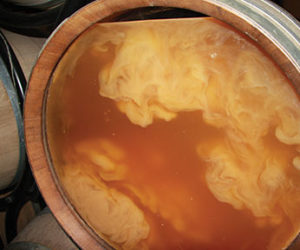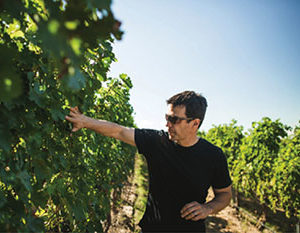Wine trends come and go, and then they come around cyclically again like they never happened. High-alcohol Zinfandels were a huge trend in the 1970s, but by the late ‘80s, big ripe wines were considered a style that was just emerging. Orange wine (macerated white wine) has wavered and waxed in popularity for more than two thousand years.
But the wine industry has never seen, in almost 10,000 years of human history, a revolution of style, craft, and ingredients that we are seeing and have seen in the last few decades of American craft brewing. Many brewers credit President Jimmy Carter for craft brewing really taking off in the early 1980s. In 1978, Carter signed H.R. Bill 1337 that legalized homebrewing in the U.S. for personal consumption or gifts.
At the time there was but a drop of craft beer in an ocean of macro-produced U.S. lager. Between 1985 and 1997, craft beer production in the U.S. expanded 20% on average per year, driven by some pioneering brands like Sierra Nevada (1980), Samuel Adams (1984), Dogfish Head (1995), Stone Brewing Co. (1996), and Russian River (1997).
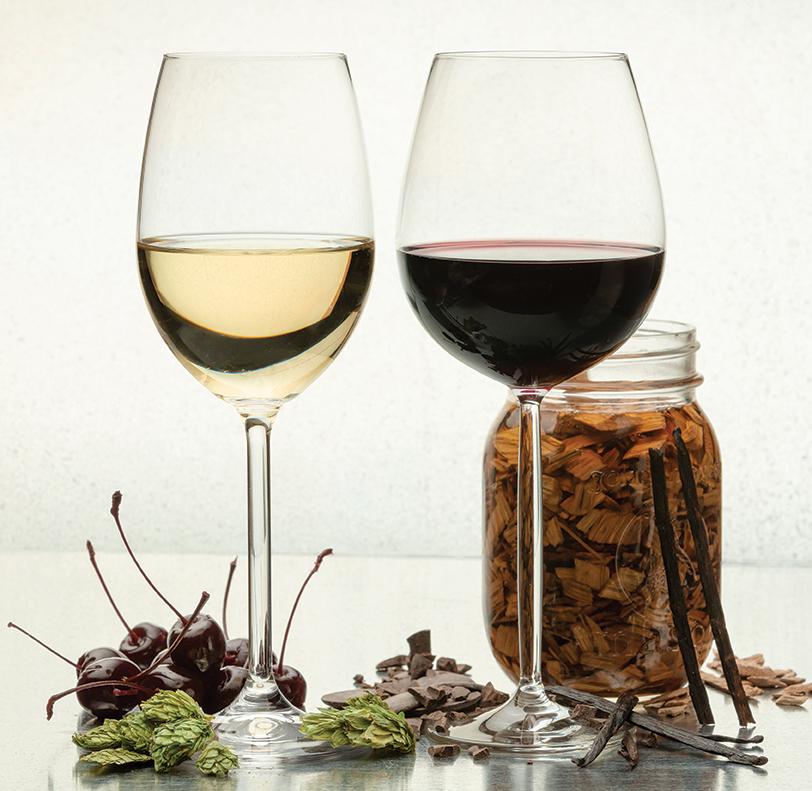
For a story about the intersection of beer and winemaking, Russian River Brewing Founder/Brewmaster Vinnie Cilurzo is a great place to start. In a 2017 interview with Brewer Magazine, this legend of brewing discussed his roots in wine, having grown up in a winemaking family and worked in the wine cellar for many years. Cilurzo began homebrewing while attending college in San Diego, California, partly because he was drawn to the idea of being able to create a beverage that was complete in less than two months, versus wine that would take a year or more. Ironically, he’s largely known now for his sour beers aged in barrels that take just as long as wine to mature. As is the story with many craft brewing pioneers, his hobby got out of control and resulted in the opening of a brewery. Though, a love of wine was there first.
The craft beer craze really exploded after the turn of the century, with the number of breweries in the U.S. exceeding 9,000 in 2021, compared to about 1,500 in 2000, according to the American Brewers Association. As the number of craft breweries across America skyrocketed, so did the creativity. From redefining the IPA beer style over and over again, adding new adjuncts and flavorings never previously imagined, incorporating wine and spirit barrels to age beer, and on and on.
More recently, a new trend has begun to emerge. Some of these established brewers are beginning to try their hand at making wine. And it isn’t just the smallest breweries you haven’t heard of, but some of the revered names and most sought after producers in the craft beer landscape have started wine labels. Odell Brewing in Fort Collins, Colorado; Foam Brewers in Burlington, Vermont; Wicked Weed and Burial Brewing, both of Asheville, North Carolina; among them. Patrick Rue, who founded The Bruery in Placentia, California, left the brewing world a decade later after achieving tremendous success to start a new venture. In 2019 he opened his own winery in Napa Valley, Erosion, which has since added small batch beer production to its lineup as well.
While commercial wine production was new to Rue and many other brewers who have taken this route, the creative spirit that craft beer is known for and techniques learned in a brewery never really left. This philosophy brought over from the brewing world is putting a new spin on wine. Wine traditionalists may scoff at the notion; however, the success of these ventures is worth taking a closer look at, especially by home winemakers who are not beholden to the bottom line if something goes awry nor limited in their creativity by market demand.
“When a brewer becomes a winemaker (particularly if its their own winery/brand), the agricultural part is a bit foreign, and there’s less of a sense of tradition or ‘that’s the way it’s always been done.’ For me, the most common area where I can impact flavor is by incorporating ingredients that fall outside of typical wine ingredients,” says Rue.
Let’s start with the first part of that quote before we get to the crazy additions that brewers are bringing to wine. More than any other factor, the quality of a wine is dependent on the quality of the fruit crushed. Fresh, ripe, cold winegrapes prevent feral ferments and the production of volatile acidity, which is the first step toward the wine becoming vinegar. On the other hand, making beer is precise, recipe- and process-focused, and egalitarian: Most ingredients are available to all brewers for a level playing field. Winemakers are limited by the quality of the vineyards and grapes they use — wine is generally about preservation of ingredient quality through fermentation. This point isn’t lost on Rue.
“Brewers have a lot of control when it comes to making beer ranging from raw material selection to process decisions. As a result, brewers tend to think of how to express certain flavors in the beers they make. Winemakers, on the other hand, tend to have less control. The grapes they have are of a certain varietal, from a certain area, and the weather is going to do what it’s going to do,” Rue says. “Much of the decisions in the grape growing process are responding to the conditions in order to achieve the best outcome. Brix and acid levels are the primary decisions that will impact flavor, where most of the other decisions are related to the health of the vines and keeping the fruit in the best shape as possible. Wines are often produced to achieve a style the brand is known for, as that’s what customers have come to expect, leaving little room for experimentation. Plus, wine is made only one season a year, where beer is continually produced, so reducing risk is more crucial for winemakers than it is for brewers.”
Of course, this is the traditional way of thinking. What if we take a page from the brewer’s playbook, particularly if the quality of grapes aren’t pristine?
Let’s Get Crazy
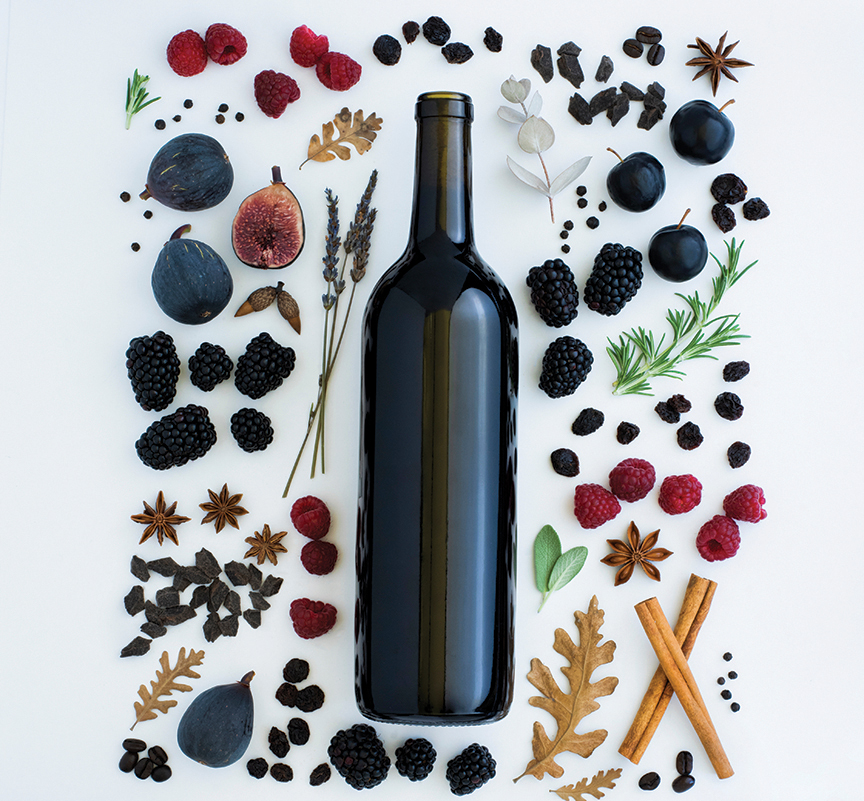
So, what are some of these ingredients that brewers-turned-winemakers are incorporating into their wines? The list Rue has executed at Erosion is already long enough to make the winemaking traditionalist a little queasy, and it likely is just the beginning for the winery that has been in business for just a few years.
“A few examples that are top of mind are dry hopping a white wine, adding sour cherries to a Chardonnay to make it a ‘rosé’ of sorts, adding cacao and vanilla beans to a Merlot, aging late-harvest Sauvignon Blanc in spirit barrels. I’ve enjoyed the results, they’ve all contributed something unique while preserving the flavor of the base wine.”
Again, these are non-traditional, but if you allow yourself an open mind, you can imagine the complementing flavors and aromas for each of these examples. This isn’t just throwing random things in wine, but instead approaching wine in a way craft brewers approach beer. It may be easier to imagine if you are already a craft beer lover who is used to these types of additions to beers, which Rue himself acknowledges.
“It takes some effort to have a traditional wine drinker come to terms with what we’re doing, but craft beer drinkers understand the concept without much further explanation,” he says.
A traditional winemaker himself at SeaSmoke Cellars in the Santa Rita Hills of California, Don Schroeder is also a craft beer aficionado. From the outside, he appreciates some of these new techniques winemakers are experimenting with. “One brewing technique being used in winemaking that I am really enjoying is dry hopping dry white wines. If done right it can add some lovely complexity to an affordable white.”
For those unfamiliar with the term, “dry hopping” is the addition of hops after fermentation is complete. And hops, like grapes, vary dramatically from variety-to-variety. Aromatic descriptors are available from suppliers to help winemakers decide what aromas may complement and add to the complexity of a white wine, but a good starting point would be those varieties described as “vinous.” A few of the most notable examples include Nelson SauvinTM hops from New Zealand, Hallertau Blanc hops from Germany, and AstraTM hops from Australia; however, other hop descriptors such as peach, pineapple, melon, lemon, and lime may also be good complements to a Sauvignon Blanc or other crisp white wine. Small hop additions in a “hop sock” or mesh bag for a few days is all that is needed, but some trial and error to dial in the right amount for your taste is to be expected.
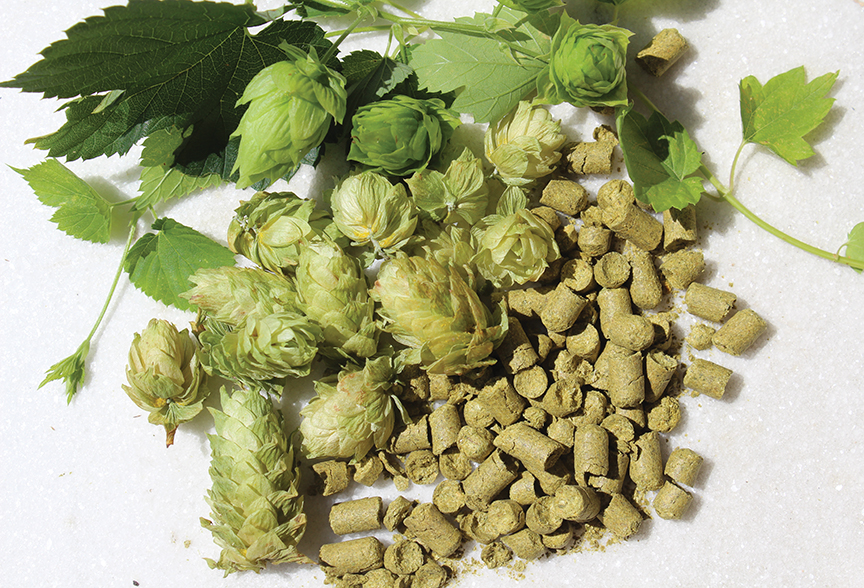
Whether it is an addition of hops, cocoa nibs, vanilla beans, spirit-soaked oak chips, or any other new brewer-inspired addition; this is a great time to split that batch of wine you are making into smaller 1-gallon (4-L) trials. Wait until fermentation is complete and then divide the wine into smaller increments with varying amounts or times of the additions and then taste the differences.
Want to get even crazier? How about Brettanomyces? As a winemaker, you know the harm introducing the “spoilage” yeast into your winemaking space can have as it can not only ruin the batch you are making with off-aromas and flavors such as the classic barnyard description, but also ruin future batches as it is extremely difficult to eradicate after it has gained a foothold. Yet, many breweries intentionally inoculate their beer with Brett (it is worth mentioning, that most of these either intentionally sour all of their beers or have separate brewing spaces for these Brett beers so as not to infect their clean styles). And these Brett beers are some of the most costly, complex, and sought-after beers being produced at breweries from Belgium to Russian River and everywhere in-between.
Wicked Weed Brewing started an offshoot wine label named Vidl in 2019 that is run by the head blender of the brewery’s sour beer program. Some of the beers Wicked Weed produces are wild fermentations, not inoculated by traditional brewers yeasts. As such, it shouldn’t come as a huge surprise that all of Vidl’s wines are also spontaneously fermented. None of their wines receive sulfite, fining agents, or anything else. Natural wine, if you will. Sourcing grapes from the same region as their hops — Washington State’s Yakima Valley, the wines are intended to express the terroir of the region. And, yes, this includes Brett in some examples.
Again, Brett should not live in the same space as your traditionally crafted wines, but it is an option if you have a separate dedicated space and enjoy the flavor and aroma. Just be careful about cross-pollinating!
Techniques from the Brewing World
Outside of experimentation, is there more to be learned from the world of brewing? Rue says there is, and I couldn’t agree more.
“The most striking thing to me is that sanitation of most breweries is on a much higher level than most wineries. While wine is much more durable than beer when it comes to sanitation and oxidation, there’s some best practices that would be well suited to both industries,” he says.
I’ve seen this firsthand. In 2001, my wife and I enjoyed having two winemaking interns from the TUM Weihenstephan in Freising (Bavaria), Germany. The cleanliness of the stainless tanks we used and care they took to clean the crusher/de-stemmer and press every night were likely factors that made our 2001 vintage wines extraordinary — the Pinot Noir and Chardonnay produced are still drinking beautifully more than 20 years later.
Another area winemakers may be able to take a tip from the brewer’s playbook, says Schroeder, comes in the form of intervention, a term winemakers often proudly state they like to minimalize. Whereas winemakers often follow the same recipe and technique year after year and “let the grapes’ expression shine,” brewers are more apt to continuously adjust a recipe until it hits all of the marks the brewer is shooting for — and then continue to make adjustments as one-off brews!
“Many brewers focus on refining a recipe by tweaking techniques and elements in their brew; one thing many winemakers can learn from. Small refinements can go a long way,” Schroeder says.
These refinements may come in the form of the type of oak used, additives and enzymes, aging durations, yeast strains, and so much more. Instead of sticking to one way to do things, the brewer-turned-winemaker would recommend branching out. In fact, that’s exactly what Rue
told me.
“I’d also encourage winemakers to step outside of their comfort zone and experiment a little bit,” he advises.
After talking to some experts and learning more about this wacky world of brewer-influenced winemaking, here are my takeaways:
• Sanitation. Brewers generally have better sanitation habits and protocol. This can keep the wines clean, topped, and healthy. Making beer with winery levels of sanitation would commonly lead to spoiled batches of beer. The take-home message: Be sanitary, keep your wines and your winery clean; maintaining brewery-level cleanliness is not required to make great wine (still, it can’t hurt).
• Additions. The main focus of those I spoke with for this article is that the number one trend coming from brewing is non-traditional additions. Dry hopping an aromatic white wine is a common trend among the brewer-turned-winemaker, as is putting herbs, spices, fruit, and cocoa nibs in bags for immersion in the wine. The pros of these techniques, as brewers will explain, are complexity is achieved non-traditionally, and may lead to better and better additions and fun new beverages. The traditional winemaker may harp on the cons: Additions of this sort take a wine away from the place where it was grown. My thought is that this is a better technique for improving wines made from marginal quality grapes.
• Brewing is a bit more recipe based/methodical in production, while winemaking is a bit more artistic and traditional. Brewers will be more likely to jump into a new technology and won’t be disturbed by taking chances and using new techniques. Ultra-premium winemakers try to preserve the quality of great vineyards, making singular wines of place and character. Winemaking is about finding the grapes no one else can. Brewers all have access to the same ingredients, so there is more of a reliance on process and science, and less on trying to persuade vineyard owners to get just one ton of that perfect Pinot Noir. Maybe we can meet somewhere in the middle on a home winemaking approach?
• More and more in recent years we are seeing brewing, winemaking, and even distilling in the same facility. As more adult beverages are made in close proximity, an exchange of process and additions move both ways through the craft. Small-production home winemaking and homebrewing follows a similar path. We are able to craft both wine and beer legally in our homes, and application of knowledge from one beverage to another gives us insight into both.
• Amateur brewers and winemakers have a distinct advantage in using non-traditional production methods — if a 5-gallon (19-L) experiment goes wrong, it’s less painful to make vinegar or dump it than if it were a 10,000-gallon (38,000-L) lot at a commercial winery or brewery. Have fun, make some mistakes, and you may end up creating something new, exciting, and popular.
In a staunchly conservative craft like winemaking, is it genius, profane, or somewhere in the middle to add cocoa nibs to an aging Cabernet, or to dry hop a Sauvignon Blanc? At the end of the day, the answer is up to you.
References:
• Bernstein, Joshua. “For Many Craft Breweries, Winemaking is the Next Frontier.” SevenFifty Daily, October 12, 2021. https://daily.sevenfifty.com/for-many-craft-breweries-winemaking-is-the-next-frontier
• Montgomery, Tyler. “Russian River Brewery: Interview with Owner Vinnie Cilurzo.” Brewer Magazine. July 26, 2013. https://thebrewermagazine.com/russian-river-brewery-interview-with-owner-vinnie-cilurzo


